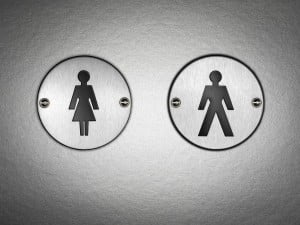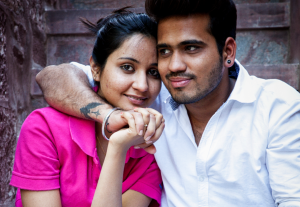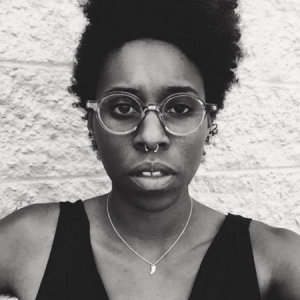
Source: Time
(Trigger Warning: References to intensely transphobic language, violence, and misgendering.)
Earlier this year, the school where I teach did a few renovations. In addition to fixing leaky radiators and repainting classrooms, gender-neutral, single occupancy bathrooms were added in a number of locations.
The impetus for this was a campaign initiated by high school students who were concerned that our near exclusive reliance on “boys” and “girls” facilities was creating problems for trans and gender non-conforming kids.
As a tenth grader explained,
“There are people at our school who don’t identify as male or female, [who] identify as male or female but are not cisgender, or [who] believe that there should be a bathroom that people feel comfortable going in if they don’t feel comfortable going into the men’s or women’s restrooms.”
At first, some adults were concerned.
My school runs 4th to 12th grade, and a number of people wondered if it would be safe to put in these new bathrooms. Would kids take advantage of the private space to make out or smoke cigarettes in the stalls?
If the bathrooms were multi-user, would nine-year-old-girls have to use a stall next to their male teachers? Would it be safe?
Ultimately, none of these concerns have come to pass.
And even if they did, I feel pretty confident that the administration would address them without backtracking on the progress already made to make bathrooms more accessible for our trans and gender non-conforming students.
But when the question of offering gender-neutral bathrooms arises, or when someone proposes legislation protecting a person’s right to use the bathroom of their choosing, a lot of people begin to worry that those above mentioned problems are inevitable.
This is an issue that comes up pretty frequently.
Because the majority of public bathrooms are specifically designed for people recognized as either men or women, the ability of people who don’t neatly fit into gender boxes to use a bathroom safely is regularly compromised.
This isn’t surprising when we realize that not only is it often against the law to use a bathroom designated for the “opposite” gender, but people often respond with hostility or violence when they think someone is in the “wrong” bathroom.
Some of this hostility occurs because many people seem to believe that trans individuals are somehow trying to “trick” them for a nefarious purpose.
Others are adamant that trans folk are not really men or really women, and because of that, they are somehow encroaching on gendered space in a way that makes cisgender people uncomfortable.
Combine this with general fears about stranger danger and sex crimes (and our deep discomfort with bodily functions), and we get a pretty fraught situation.
But when we look at the arguments against inclusive bathrooms, or opposition to legal protections for individuals to use their chosen bathroom, we see that most are based on misinformation and unfounded fears.
Here are some of the issues that we need to unpack.
Myth #1: Allowing people to use the gendered bathroom of their choice or providing multi-user, mixed-gender bathrooms is unsafe for cisgender women and children.
Safety fears are based on a few misconceptions.
One is that allowing trans women to use women’s bathrooms or providing multi-user mixed-gender bathrooms will create a perfect opportunity for predators to attack their victims.
This is completely erroneous view that is not only oppressive, but also puts trans people in danger.
That was the stance taken by Michelle Duggar, a reality TV star known for her 19 births, fundamentalist Christianity, and more recently, a vocal and hostile opposition to an Arkansas ordinance which would have protected a trans person’s right to use the bathroom associated with their gender.
Duggar recorded a really disturbing message that robo-called potential voters.
The missive intentionally misgendered trans folk with the aggressive warning that the bill:
“[hurt] the safety of Northwest Arkansas women and children [by allowing] men – yes, I said men – to use women’s and girls’ restrooms, locker rooms, showers, sleeping areas, and other areas that are designated for females only. I don’t believe the citizens of Fayetteville would want males with past child predator convictions that claim they are female to have a legal right to enter private areas that are reserved for women and girls.”
In addition to the blatant transphobia of this message, the notion that protecting the rights of trans and gender non-conforming individuals to use whatever bathroom they please will allow predators to enter a bathroom is just illogical and the implication that trans women are more likely to be predators is just wrong.
Not only are the vast majority of sexual assaults against both adults and children committed by someone known to the victim, usually a hetero-identified cisgender man, but the type of predator conceived of by this scenario is not the type of person to avoid a gendered bathroom simply because social codes and laws prohibit entrance.
Pushing the idea that cisgender men will pose as women to gain entrance into a woman’s bathroom to commit a sex crime, or that they will use the law to justify their presence there, is fear mongering and another way to justify trans oppression.
Not only are there are already laws protecting people from criminal conduct in public restrooms, but the organization Media Matters for America found that this simply hasn’t happened.
They contacted representatives in states that have enacted protections for trans individuals to use bathrooms associated with their gender and learned that not one of the twelve states with such laws reported an increase in sex crimes committed in bathrooms as a result of the legal changes.
Myth #2: Gender separated spaces are crucial in our society since men and women have inherently different needs.
The idea that men and women require distinct spaces is one that people from religious conservatives to some feminists often turn to when trying to shore up support for their positions.
One of the most outspoken feminists to adopt this view is Maryland based attorney, Catherine Brennan.
Brennan (who has been labeled a TERF, or trans-exclusionary radical feminist, by her critics) has publicly opposed protections for trans people, including the right of trans women to use women’s bathrooms.
Recently she tried to explain her stance to Bustle magazine.
“I think women have a right to say we are women, we have a shared experience of being a woman and don’t want to organize with [trans women]. Let women have their space. If they’re excluding you because you’re male, well, I’m sorry, but you are male. Deal with your reality. We didn’t create that reality, that reality exists.”
It is incredibly troubling to see comments like this used to justify exclusion in the name of safety, unity, and—yes—feminism.
But it’s important to acknowledge that such comments are not only isolated to a few outliers. Just look at the fact that this was still an issue at the Michigan Womyn’s Music Festival this past summer.
Much more common, however, are conservative and religiously motivated arguments about the differences between men and women.
For example, the website of a 2014 Republican candidate for Governor of Arkansas, Curtis Coleman, explained that if the proposed bathroom ordinance in Fayetteville passed, everything their conservative Christian movement believed in would be under attack:
“Your faith will be criminalized. Judeo Christian faiths predominately [sic] include instruction to be modest. This ordinance infringes on what many believe to be sacred… [It] poses a threat to public safety and privacy rights by forcing people of opposite sex to share public bathrooms, dressing areas and showers. (refer to the ordinance stating that gender, gender identity, gender expression or sexual orientation, can be ‘real or perceived’)… Family values can be scrutinized in schools. Parents and guardians may be held accountable by the City of Fayetteville and any person who may issue complaint about a child’s professed belief system. Parents who opt to teach values differing with those of The City of Fayetteville may feel pressured to coach their children not to express core values of the home.”
All this just from protecting a person’s right to pee!
Other people, regardless of political or religious leanings, feel that it would just be uncomfortable for women to use a bathroom with men present and that men would just be horrified by the reality of female bathroom habits. (Periods! Excretions! Make-up application!)
But these these arguments don’t really look at the fact that multi-gender bathrooms are generally single user, or if multi-user, made up of single user stalls with shared sinks.
Plus, they imply that if people really knew the truth about what the other gender does behind closed doors, they would be horrified by what they’d learned.
Who Is Really at Risk in Public Bathrooms
In reality, the people who are most at risk in public bathrooms are trans and gender non-conforming individuals who are subject to verbal and physical attacks at an alarming rate.
The Canadian performer and author Ivan Coyote writes of using women’s bathrooms as a trans person,
“Every time I bring up or write about the hassles trans and genderqueer people receive in public washrooms or change rooms, the first thing out of many women’s mouths is that they have a right to feel safe in a public washroom, and that, no offense, but if they saw someone who ‘looks like me’ in there, well, they would feel afraid, too. I hear this from other queer women. Other feminists… What is always implied here is that I am other, somehow, that I don’t also need to feel safe. That somehow their safety trumps mine… If there is anything I really do understand, it is being afraid in a public washroom. I am afraid in them all the time, with a lifetime of good reason.”
In addition to personal anecdotes (of which there are many!), a 2013 study from the Williams Institute found that transgender people experience high levels of discrimination and harassment when trying to use public bathrooms. Of the respondents:
- 68% reported verbal harassment, which in some cases, involved the police being called
- 18% of respondents reported they were denied access to a restroom
- 9% were physically assaulted. In some instances, this included being forcibly removed from the restroom and even sexually assaulted
Far from the rarely thought about experience cisgender folks have with bathrooms, using a public facility can be a daily struggle for a trans or gender non-conforming person.
Advocating for Inclusive Bathrooms
Deconstructing the fears about integrating bathrooms can go a long way to making an important change. Here are three other ways:
1. Know Your Facts and Your Rights
According to LAMBDA Legal,
“There is no rule that a person must look a certain way to use a certain restroom. Courts have increasingly found that discrimination against transgender people is sex discrimination, so it’s not acceptable to institute different kinds of bathroom rules for transgender and non-transgender people.”
2. Start Close to Home
If your school, employer, religious institution, or gym doesn’t have a gender-neutral bathroom, or makes it hard for trans people to use the bathroom associated with their gender, bring the issue up with the management or administration.
The students at my school found some teachers who supported them, and then they brought the issue to the head of the high school and saw real results.
As a sophomore named Anna explained, “The administration was quick to respond on the issue and provided a genderless bathroom, [and] the outcome raised awareness around gender identity issues.”
3. Fight for Broader Legal Change
Contact an organization that is working on this issue. Getting in touch with your local LGBTQIA+ community center, LAMBDA Legal, the Transgender Law Center, or the ACLU, will probably be a better initial route than going directly to your local congressperson (though you can always do that as well).
***
Bathroom access is a basic human right. But when a person’s appearance or body doesn’t conform to what people think of as male or female, this right is often denied.
Challenging assumptions and advocating for inclusive bathrooms can help make safe bathroom use a reality for everyone.
For information on safer bathroom use, check out the Transgender Law Center’s very helpful guide, Peeing in Peace.
[do_widget id=”text-101″]
Ellen Kate is a Contributing Writer for Everyday Feminism. She’s a health educator, sometime writer, and mom. After doing a BA in Women’s Studies in her hometown of Vancouver, Ellen moved to New York where she did a Master’s degree in Health and Human Sexuality Education. Since then, she has worked at Manhattan’s Museum of Sex, developed sex education curricula in Mumbai, India, and run HIV prevention programs for at-risk teens in the South Bronx. Currently, Ellen teaches human sexuality at Brooklyn College (something she also did at Rutgers University). For the past eight years, her main gig has been coordinating the middle and high school health education program at a school in Brooklyn. Ellen also runs About.com’s LGBT Teens site. Before that, she wrote for Planned Parenthood’s teen website and blogged about sex education for gURL.com. More of Ellen’s writing can be found here. In addition to work-related projects, Ellen spends a lot of time with her 8- and 5-year old kids, tries to find time to run, and dreams of learning another language. Follow her on Twitter @ellenkatef. Read her articles.
Search our 3000+ articles!
Read our articles about:
Our online racial justice training
Used by hundreds of universities, non-profits, and businesses.
Click to learn more
Most Read Articles
- « Previous
- 1
- …
- 30
- 31
- 32



















